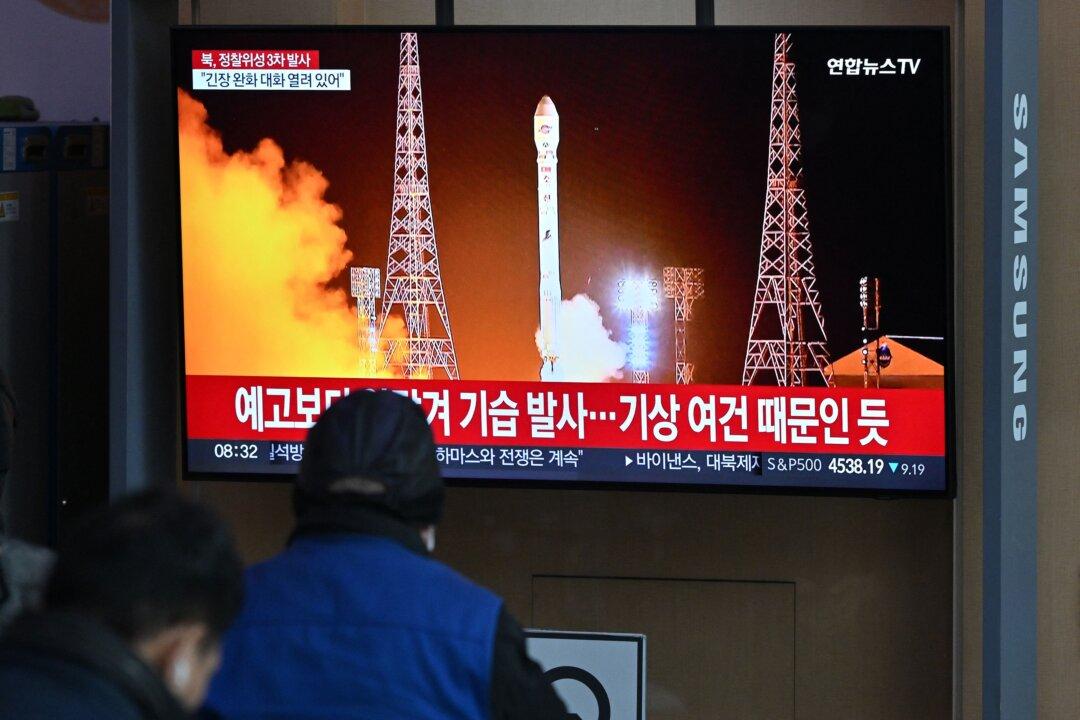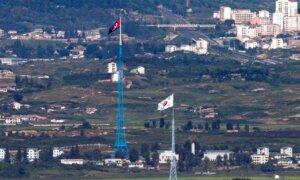North Korea’s launch of a reconnaissance satellite and follow-up acts unfolded like a well-orchestrated blitzkrieg. On Nov. 21, North Korea notified the Japanese Coast Guard that it would launch the spy satellite between Nov. 22 and Dec. 1 and designated three expected zones of falling debris. However, it launched the satellite by surprise on the night of Nov. 21, thus proving that the regime doesn’t care about the safety of ships navigating the expected debris-falling zones.
On the next day, Pyongyang announced the “successful launch of the new rocket Chollima-1 carrying the reconnaissance satellite Manrikyong-1.” Obviously, by the provocative surprise launch, North Korea once again ridiculed the U.N. Security Council Resolutions 1874 and 2087, which prohibit all launches by the DPRK using ballistic missile technology, and violated the Inter-Korean Military Agreement of Sept. 19, 2018, in which the two Koreas promised to “cease all hostile acts in all domains including land, sea, and air” by 2018.
On the next day, North Korean leader Kim Jong-un declared, “In addition to a powerful punch that can strike targets thousands of kilometers away, we now put ‘eyes’ on it that can look down thousands of kilometers.”
By saying so, he boasted of achieving one of the “five strategic tasks” presented at the eighth Party Congress in January 2021: “improvement of accuracy in striking targets within a 15,000 km range.” When the Seoul government, responding to the North’s provocative act, temporarily suspended the enforcement of Article 1, Paragraph 3 of the agreement that restricts aerial surveillance activities over the area close to the demilitarized zone, the Pyongyang regime reacted much more toughly by declaring “complete abandonment” of the military agreement. The North also warned that South Korea would pay a heavy price for its “irresponsible and grave military provocation” and that it would forward-deploy strong military forces to the front-line area.
Naturally, North Korea’s attempt to shift the responsibility for the doomed agreement to South Korea isn’t surprising. It has done so repeatedly. During the five years since the signing of the agreement, North Korea has repeatedly violated it dozens of times with coastal artillery firings, shots at truce line guard posts, drone infiltrations, and missile launches.
In 2022 alone, North Korea test-fired more than 100 missiles, including short- and long-range ballistic missiles, cruise missiles, intercontinental ballistic missiles, submarine-launched ballistic missiles, pull-up missiles, hypersonic missiles, and torpedoes that it said would deliver tactical warheads. In 2023, it has so far launched more than 50 missiles or projectiles. In addition, it put coastal artilleries on the firing posture some 3,400 times. This is why during the parliamentary audit on Oct. 27, Defense Minister Shin Wonsik said that North Korea’s violations amounted to 3,600 times.
Meanwhile, the ROK Marine Corps stationed in the northwestern islands close to the North Korean coast had to spend more than 10 billion won ($7.7 million) just for transporting heavy cannons inland for training, in adherence to the agreement.
North Korean soldiers in the Panmunjom Joint Security Area (JSA) are now armed again with handguns while reconstruction movement is spotted at the sites of 11 truce-line guard posts dismantled by the military agreement. In parallel, the Pyongyang regime now brags loudly that its spy satellite is taking pictures of “U.S. targets” such as the White House, U.S. aircraft carriers, U.S. military bases on Guam, U.N. Command rear bases in Japan, etc.
Many South Korean pundits regard this as an extension of the dangerous nuclear game that North Korea has engaged in, aiming to make the United States withdraw from the Korean Peninsula by instilling nuclear fear among the American people. Like this, North Korea has swiftly taken seemingly planned steps one by one from the surprise satellite launch and annulment of the inter-Korean military agreement to blame shifting and tension building. In this way, the Sept. 19 Military Agreement is now on the verge of being put into the historical junkyard.
Truly, North Korea’s blitzkrieg, resembling the Oct. 7 Hamas attack on Israel, leaves in its wake urgent security tasks for South Korea. The first principle that South Korea must adhere to in responding to the North Korean tension building is to depart from the submissive approach of past governments that spoiled North Korea and instead engage in sufficient responses. If South Korea fails to do so, the promised “Peace through Strength” by the Yoon Suk-yeol government will end up as empty rhetoric.
Because North Korea will abandon provocation and come out for dialogue and cooperation only when it acknowledges that, it has nothing to gain from provocation toward the South, the “Peace through Strength” must be a genuine policy for sustainable peace and coexistence, not a confrontational one. On the contrary to this, the unlimited submissiveness and doing nothing against the DPRK’s evolving nuclear prowess is definitely a short-sighted policy that will eventually reduce inter-Korean relations into a predator-prey dynamic in which South Korea has to rely solely on North Korea’s mercy for its survival.
Adhering to this principle, the ROK military should take measures such as resuming aerial surveillance, reinstating military exercises, and elevating the alert status in the northern part of Seoul and the West Sea. If the DPRK restores the 11 guard posts, the ROK should respond by increasing by dozens such posts. The assertion of the former Seoul government at the signing of the military agreement in 2018 that the dismantling of surveillance posts by both sides in equal numbers was fair was a sophistry, as North Korea had nearly three times the number of surveillance posts as South Korea.
South Korea should take corresponding measures if North Korea brings firearms into the Joint Security Area at Panmunjom. It should respond with a robust counterforce deployment to the North’s forward deployment of military forces such as large-caliber multiple rocket launchers, tactical nuclear missiles, and drones. Likewise, all infiltrating drones should be shot down without hesitation. The ROK Air Force’s explanation that they couldn’t shoot down the drones at the end of 2022 because of concerns about civilian casualties was perceived as a dubious excuse. With a mission-oriented command system, front-line commanders should be able to respond first and report later.
Lessons from Hamas aren’t insignificant. While there are lessons to be learned from launching rockets in numbers that surpass defense capabilities, as seen in the significant damage inflicted on Israel, there’s also much to learn from the fact that if the Iron Dome hadn’t functioned, Israel would have suffered even greater damage, with Ben Gurion Airport and Air Force bases paralyzed.
This is why the ROK military needs to urgently purchase such defense systems to fill the gap until the domestic production of short-range anti-aircraft systems. In sum, South Korea should thoroughly consider and prepare for the surprise capabilities of the North Korean military, probably hundreds of times more powerful compared to Hamas.
North Korea’s spy satellite also reminds South Korea of the importance of enhancing both independent and alliance capabilities to deter the growing nuclear threat from the North. A task in this regard may be not to underestimate the capability of North Korea’s spy satellite and the significance of the DPRK–Russia arms sales and cooperation over military technologies. Although the ROK military assessed last time that the North’s satellite has no military value, South Korea shouldn’t rule out the possibility of North Korea hiding its real capability or Russia helping it to quickly upgrade resolution.
North Korea has so far emphasized securing the “five strategic weapons,” such as hypersonic missiles, multiple-warhead guided technology, solid-fuel ICBMs, nuclear-powered submarines, and reconnaissance satellites. Russia may have given or may give technology related to these weapons. This reality confers to the Seoul government a new diplomatic task over how to dissuade Russia from such a dangerous deal, a superpower comparable to the United States in terms of nuclear strength and space technology.
Another pressing challenge facing South Korea may be how to handle the Joint Declaration on the Denuclearization of the Korean Peninsula signed by the two Koreas in 1991. Frankly speaking, now is the time—or maybe too late—for South Korea to go through the formal process of discarding it. Holding onto the joint declaration, which agreed on the “mutual prohibition of enrichment and reprocessing activities and possession of the nuclear weapons,” while North Korea has become the world’s ninth nuclear-armed state with a growing nuclear arsenal and evolving nuclear doctrines, must be just silly and absurd.
By formally abandoning the joint declaration, South Korea needs to declare both domestically and internationally that it can commence enrichment and reprocessing for nuclearization at any time in the future when there are sovereign decisions and alliance agreements.



